
The Amami tip-nosed frog is a species of frog in the family Ranidae. It is endemic to the Amami Islands, a part of the Ryukyu Islands, Japan. Specifically, it is known from the islands of Amamioshima and Tokunoshima.
Odorrana exiliversabilis is a species of frogs in the family Ranidae that is endemic to southeastern China where it is found in Fujian, western Zhejiang, and southern Anhui provinces. These frogs can be found in mountain forest streams and are common in suitable habitat. The species is not considered threatened by the IUCN.

Graham's frog – also known as the diskless-fingered odorous frog – is a species of frog in the family Ranidae. It is found in China and Vietnam. Presumably it is also found in Myanmar in areas adjacent to its Chinese distribution area.
Odorrana hainanensis is a species of frogs in the family Ranidae that might be endemic to Hainan Island, China; there is one record from Guangxi. Prior to its description in 2001, it was confused with Odorrana andersonii.

Holst's frog is a species of frog in the family Ranidae. It is endemic to the Ryukyu Islands of Japan. It occurs on mountains of the Okinawa and Tokashiki islands. It lives in primary or recovered secondary broad-leaved evergreen forests. It is threatened by habitat loss caused by road and dam construction.
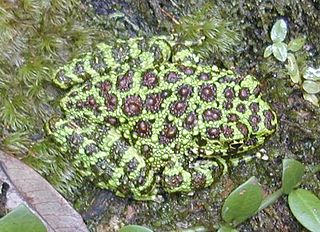
Ishikawa's frog is a species of frog in the family Ranidae. It is endemic to Okinawa Island, one of the Ryukyu Islands of Japan. It has been described as the most beautiful frog in Japan.
Odorrana kuangwuensis is a species of frog in the family Ranidae that is endemic to China. It is found in northeastern Sichuan and northwestern Hubei. Its name refers to the type locality, Mount Guangwu in Nanjiang County, northern Sichuan.
The Ryūkyū brown frog is a species of true frog endemic to the Ryūkyū Islands, specifically Okinawa and perhaps neighboring islands.
Odorrana orba is a species of frog in the family Ranidae. It is found in southeastern Laos and central Vietnam. The specific name orba is Latin for "orphan", referring to the fact that this species was—at the time of species description—known in Vietnam only from a single juvenile.

The Kampira Falls frog, also known as the Yaeyama harpist frog or harpist brown frog, is a species in the true frog family (Ranidae). Until recently known as Rana psaltes, it is found on Ishigaki and Iriomote in the Yaeyama Islands of Japan, as well as on Taiwan.
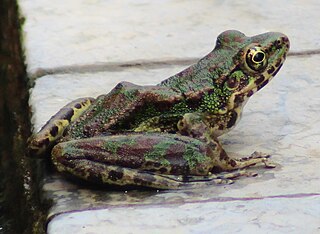
Odorrana schmackeri is a species of frog in the family Ranidae. It is endemic to China and distributed in southern and south-central China. Reports from Thailand and Vietnam require confirmation.
Odorrana supranarina is a species of frog in the family Ranidae. It is endemic to Ryukyu Archipelago, Japan, and is known from the islands of Ishigaki and Iriomote, both in the Yaeyama Group. The specific name supranarina refers to the large size of this species —at the time of the species description, it was the largest member of the so-called Rana narina complex. Common name greater tip-nosed frog has been coined for it.
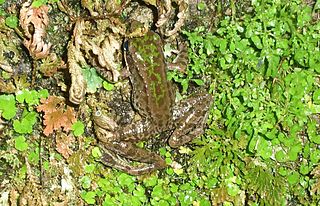
Odorrana swinhoana is a species of frog in the family Ranidae. It is endemic to Taiwan and widely distributed in hilly areas below 2,000 m (6,600 ft). It is named for Robert Swinhoe, a British naturalist and diplomat. Its common names include Swinhoe's brown frog, Bangkimtsing frog, brown-backed odorous frog, Taiwan odorous frog, and Taiwan sucker frog.
Odorrana trankieni, also known as Trankien frog or Tran Kien's odorous frog, is a species of frogs in the family Ranidae. It is endemic to northern Vietnam. Its natural habitats are montane evergreen forests and secondary mixed evergreen bamboo forests at elevations of 300–700 m (980–2,300 ft) above sea level.
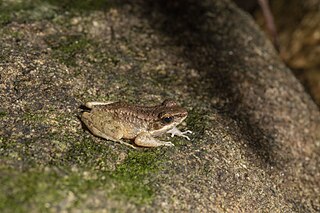
Odorrana utsunomiyaorum is a species of frog in the family Ranidae. It is endemic to Ryukyu Archipelago, Japan, and is known from the islands of Ishigaki and Iriomote, both in the Yaeyama Group. The specific name utsunomiyaorum honours Taeko and Yasuaki Utsunomiya for their contributions to clarifying the amphibian fauna of the Yaeyama Group.
Odorrana wuchuanensis, also known as the Wuchuan odorous frog or Wuchuan frog, is a species of frog in the family Ranidae. It is endemic to southern–central China: Guizhou, Guanxi, and Hubei provinces. For a long time, it was only known from a single limestone cave in Baicun, Wuchuan. Adults live in limestone caves in karst areas, often on cliffs inside caves, near ponds. Tadpoles can be found also outside cases.
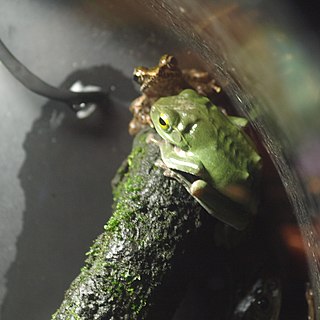
Zhangixalus viridis is a species of frog in the family Rhacophoridae. It is endemic to the Ryukyu Islands, Japan, and known from Okinawa, Iheya and Kume Islands of the Okinawa Group. Zhangixalus amamiensis from the Amami Group was formerly included in this species as a subspecies.

Odorrana, commonly known as odorous frogs, is a genus of true frogs (Ranidae) from East Asia and surrounding regions. Many of these frogs inhabit fast-flowing mountain streams, and they typically have a remarkably pointed snout, as evidenced by common names like tip-nosed frog and scientific names like nasica or nasutus.
Rana ulma is a species of frog in the family Ranidae. It is endemic to Okinawa Islands, in the central Ryukyu Islands of Japan. It is currently only known from northern Okinawa Island and from Kume Island. Common names Okinawa frog and Ryukyu brown frog have been used for this species; the latter can refer to this species or to Rana kobai. The specific name ulma means "coral island" in Uruma dialect of Okinawa.











